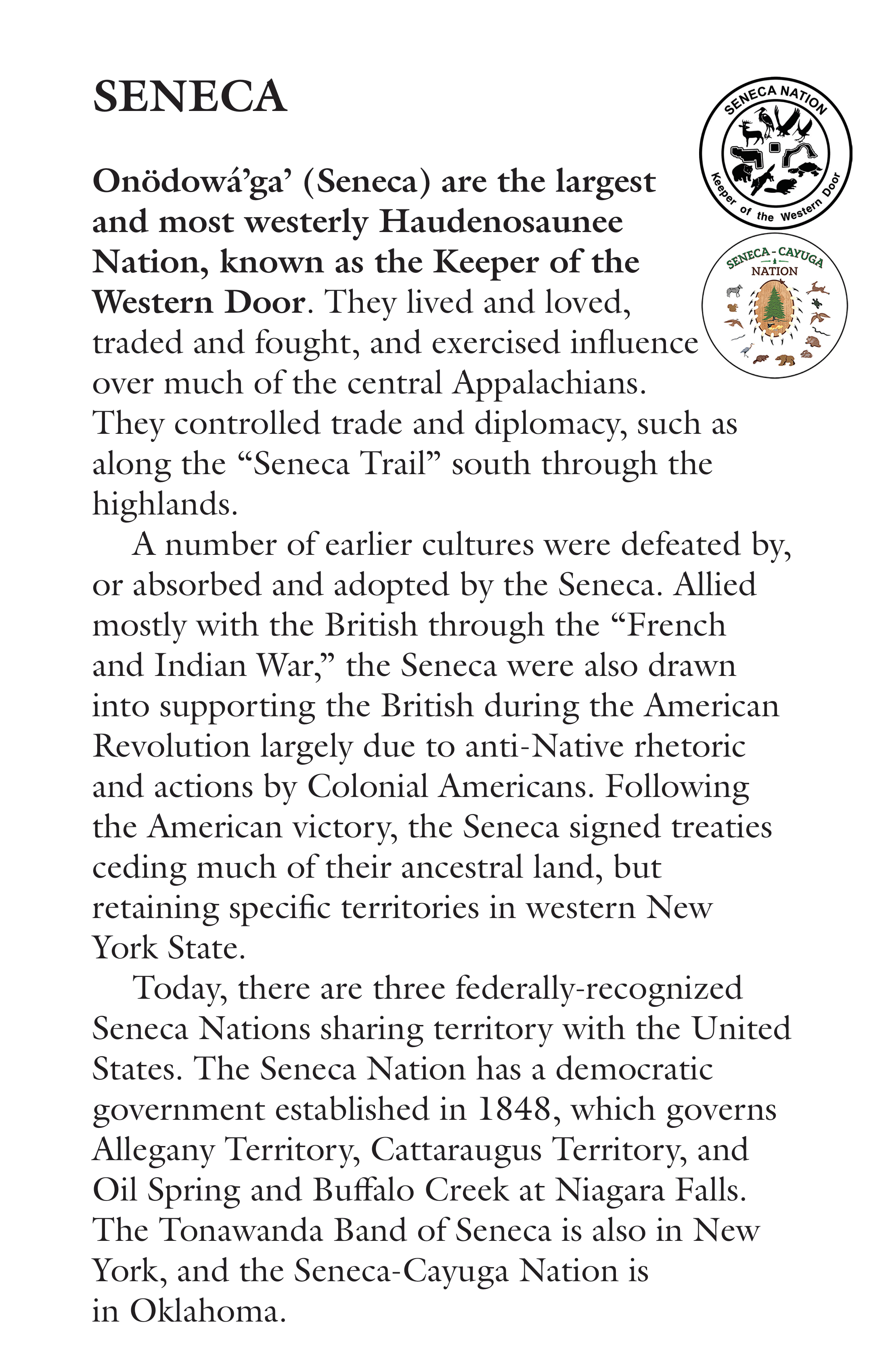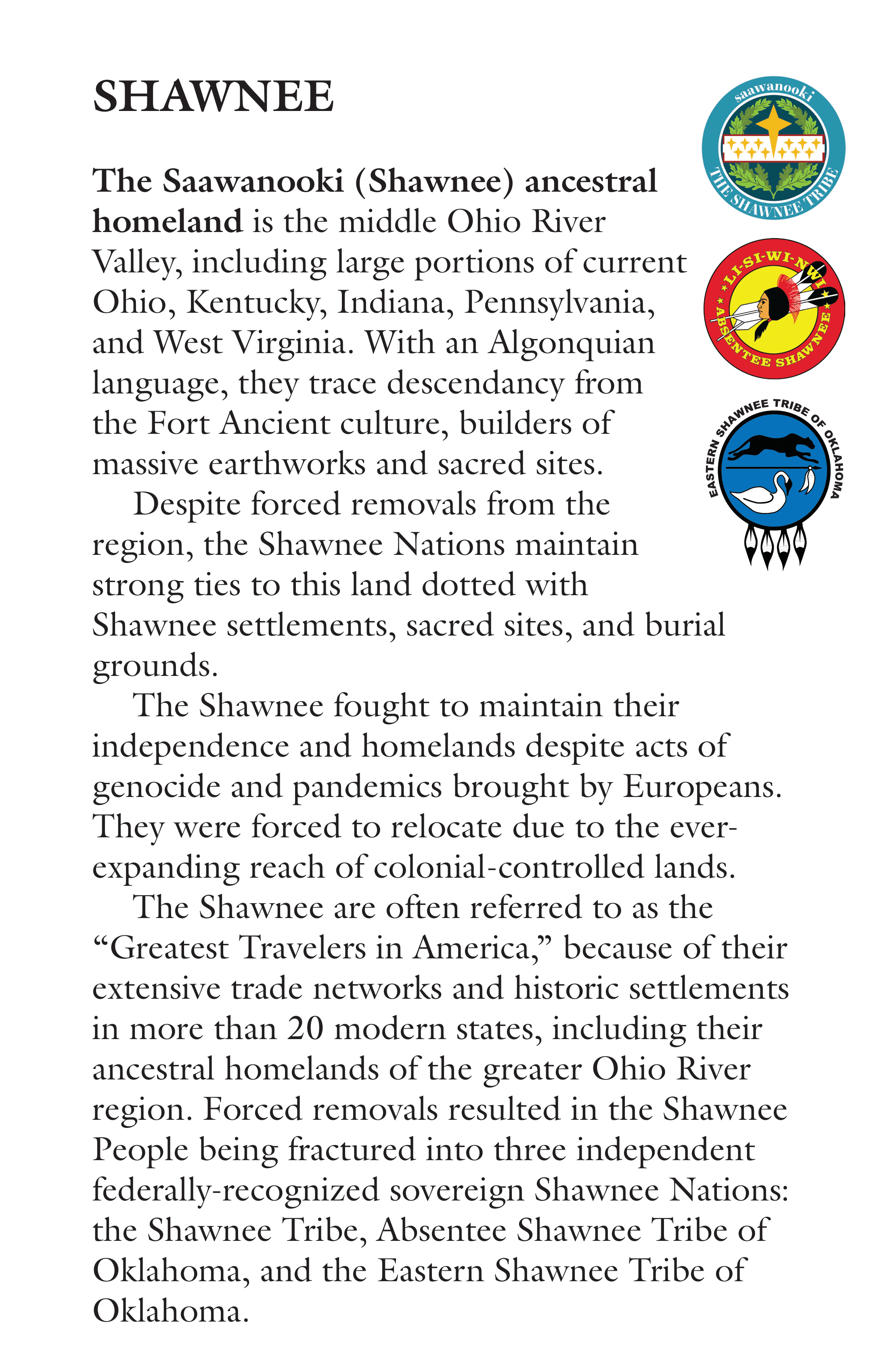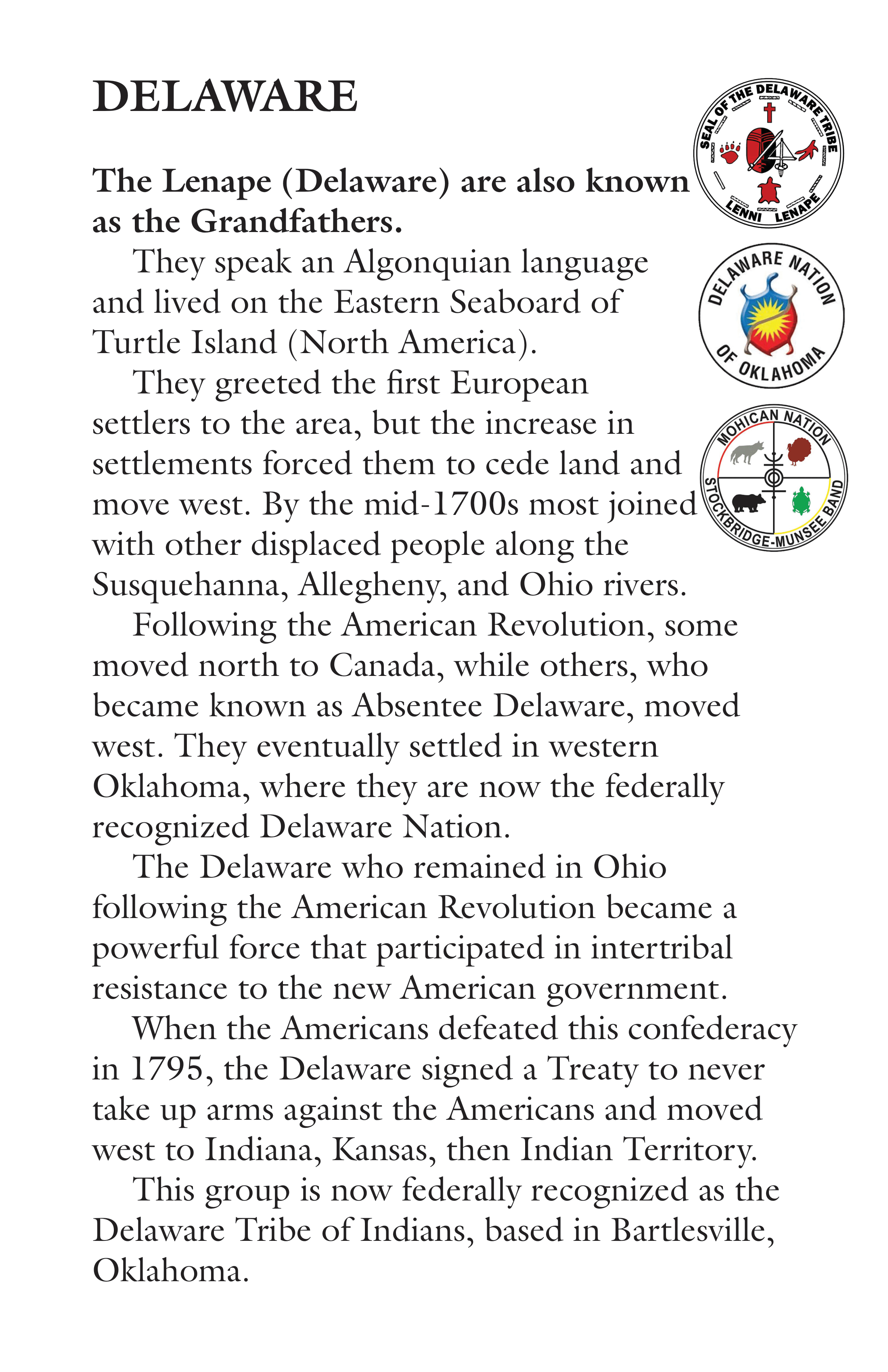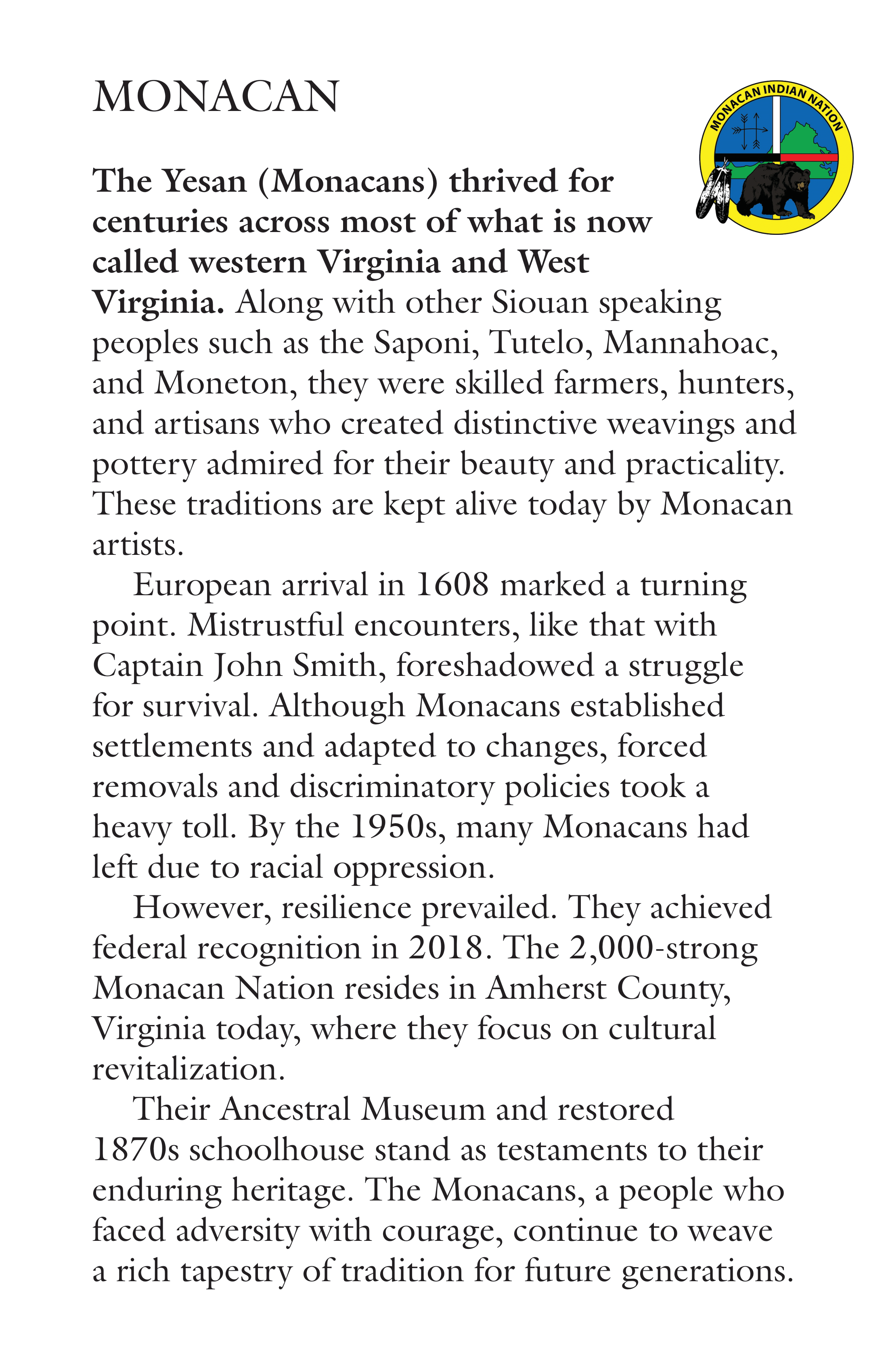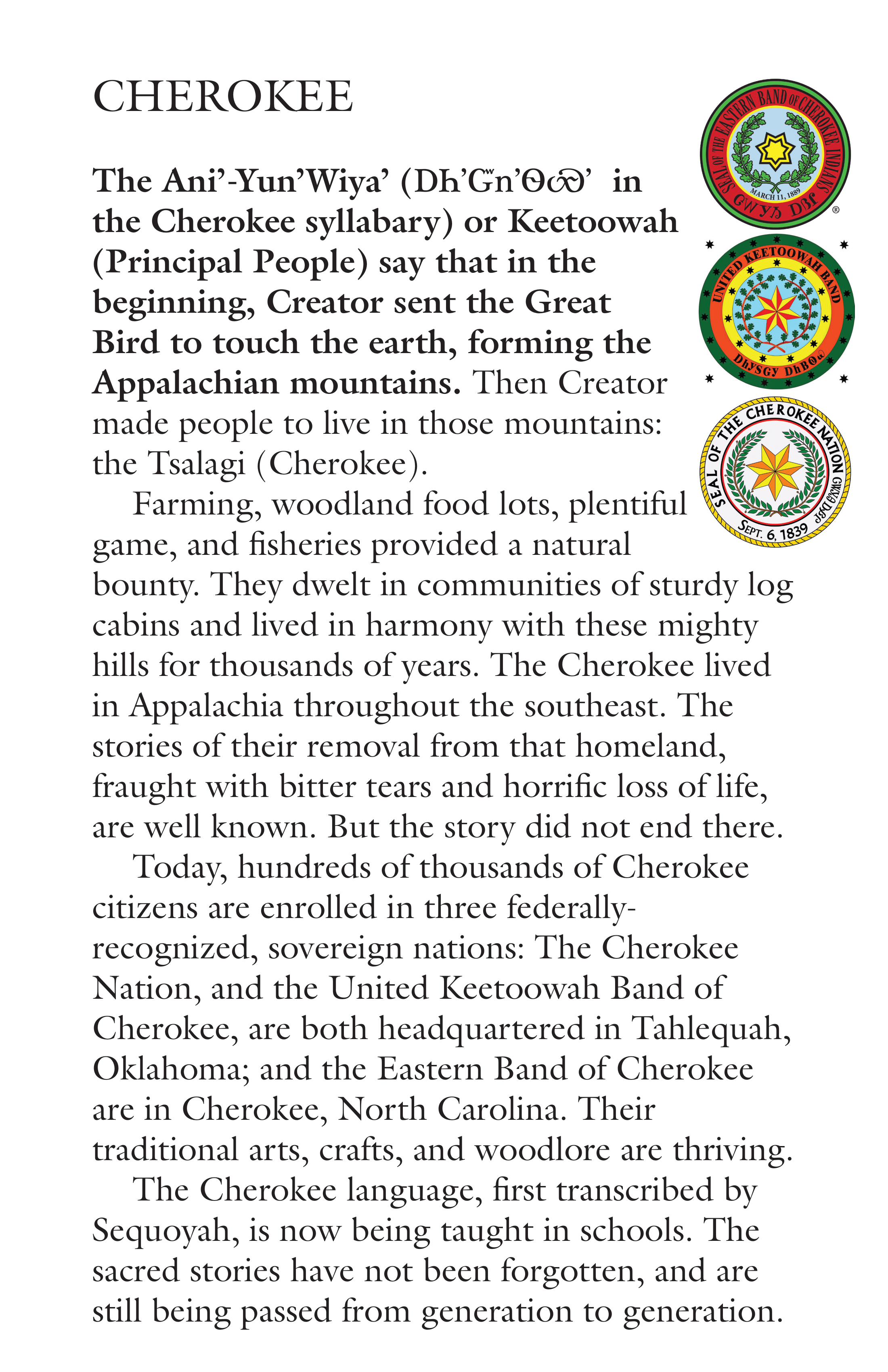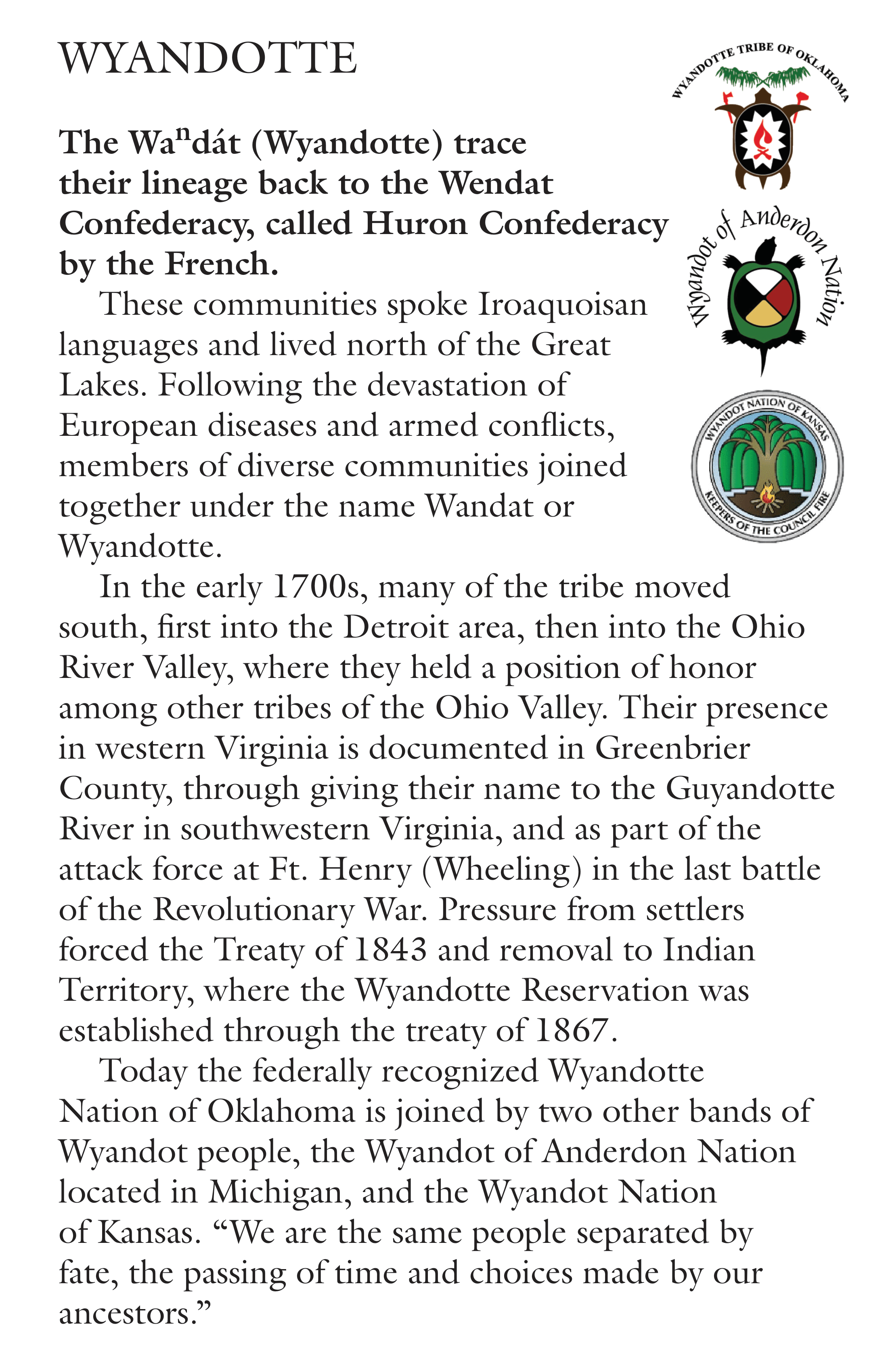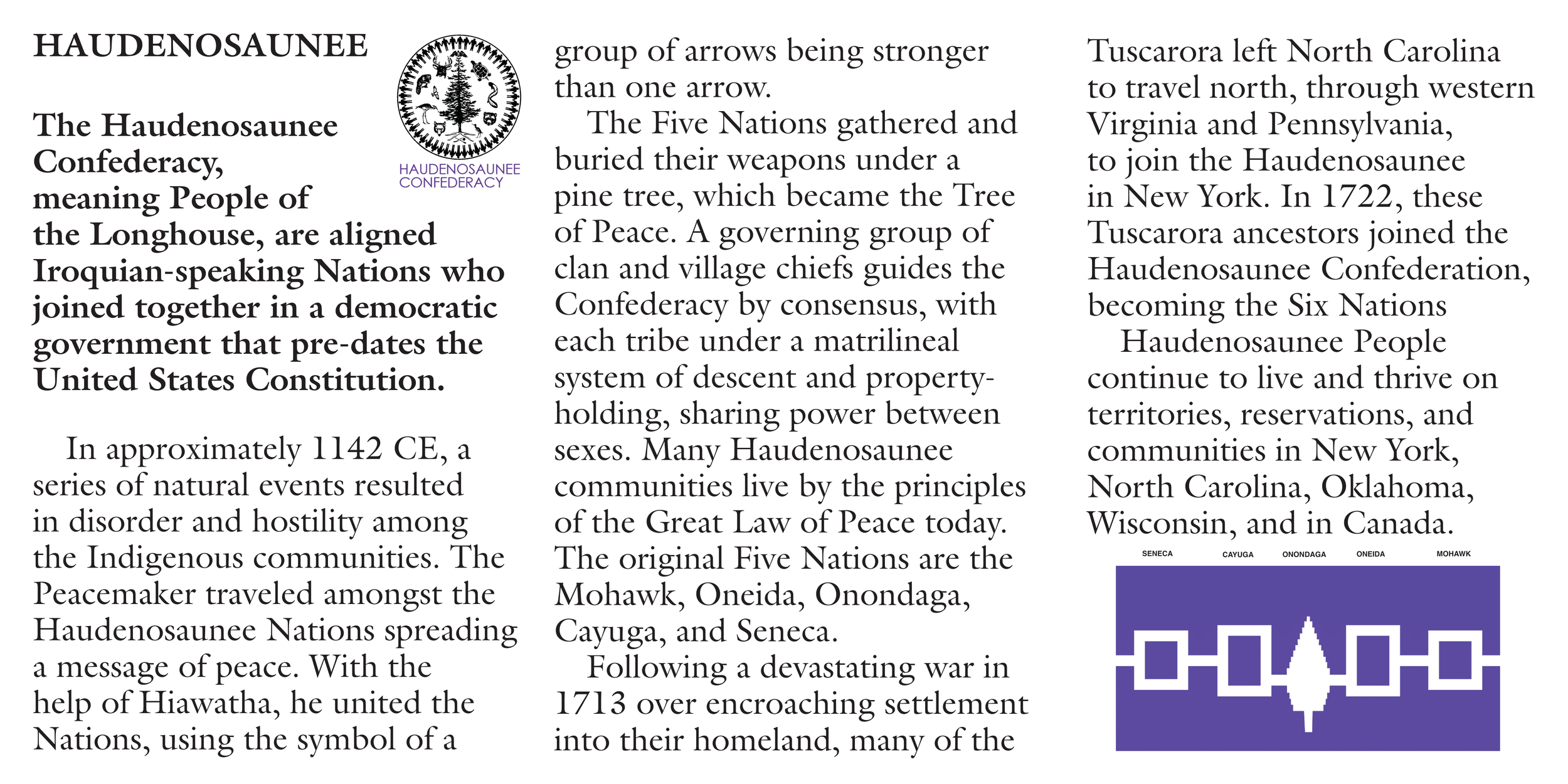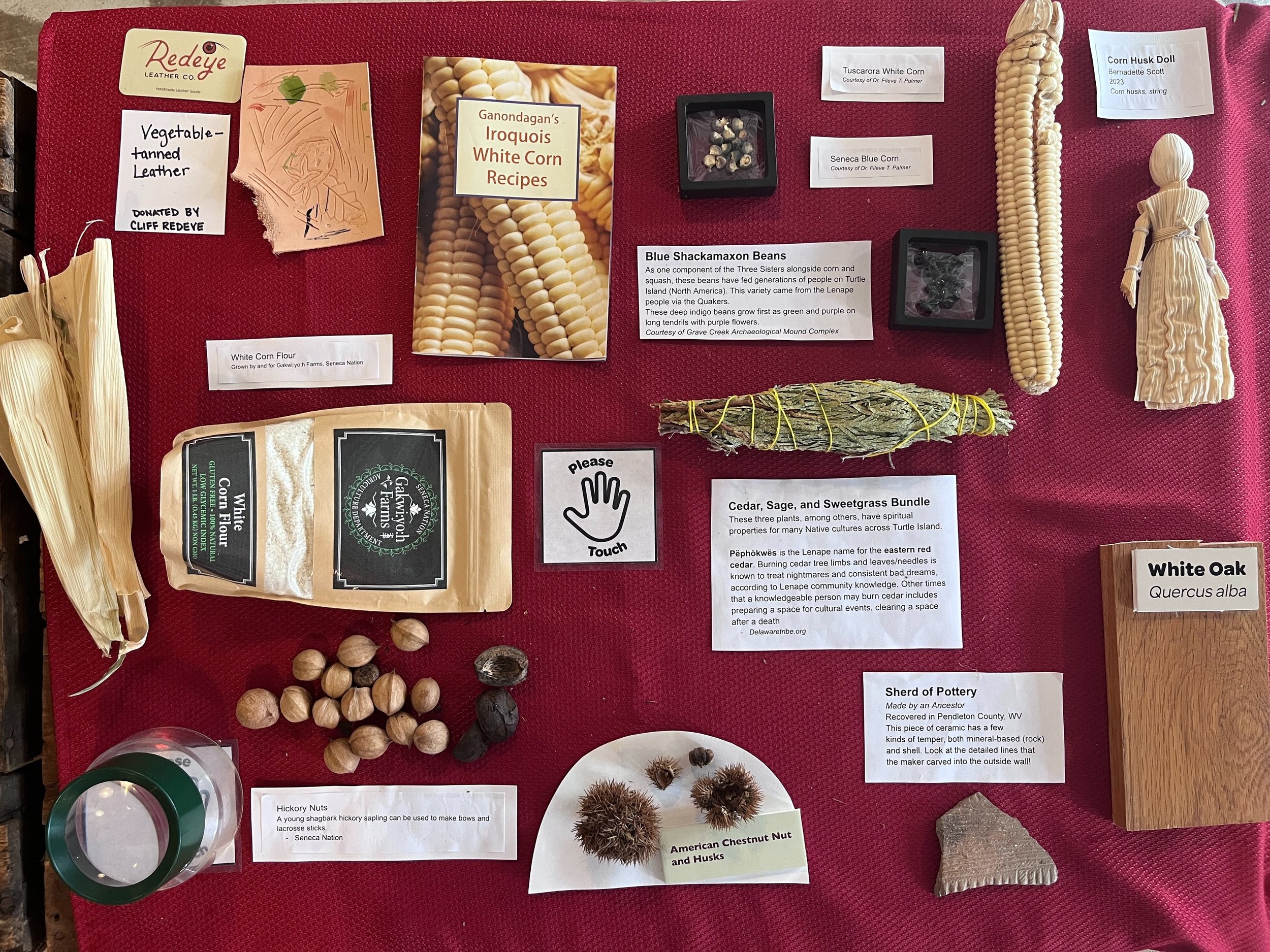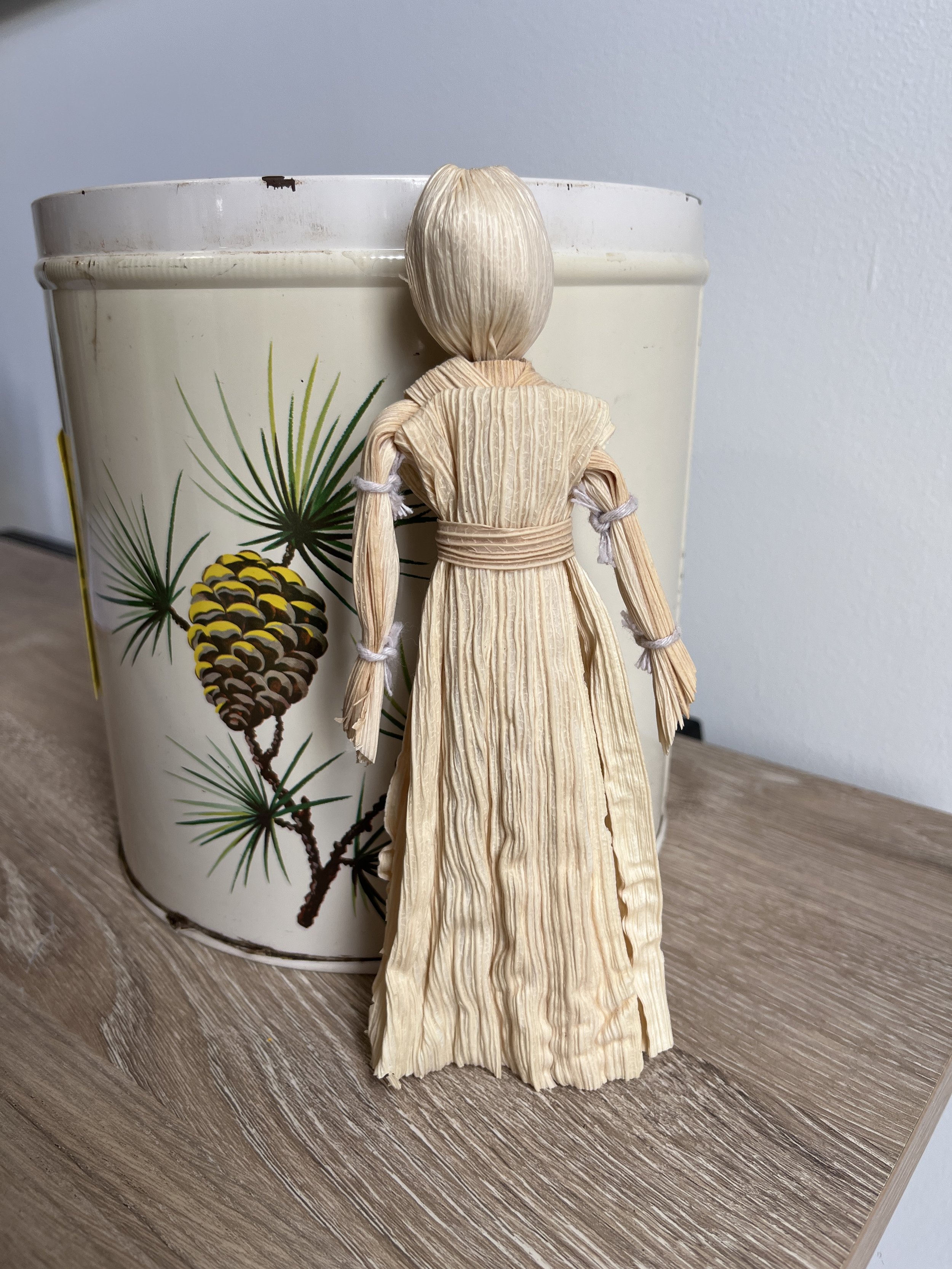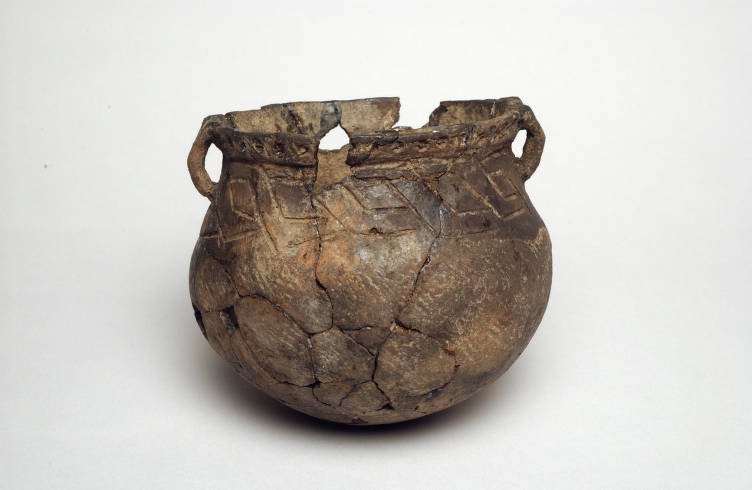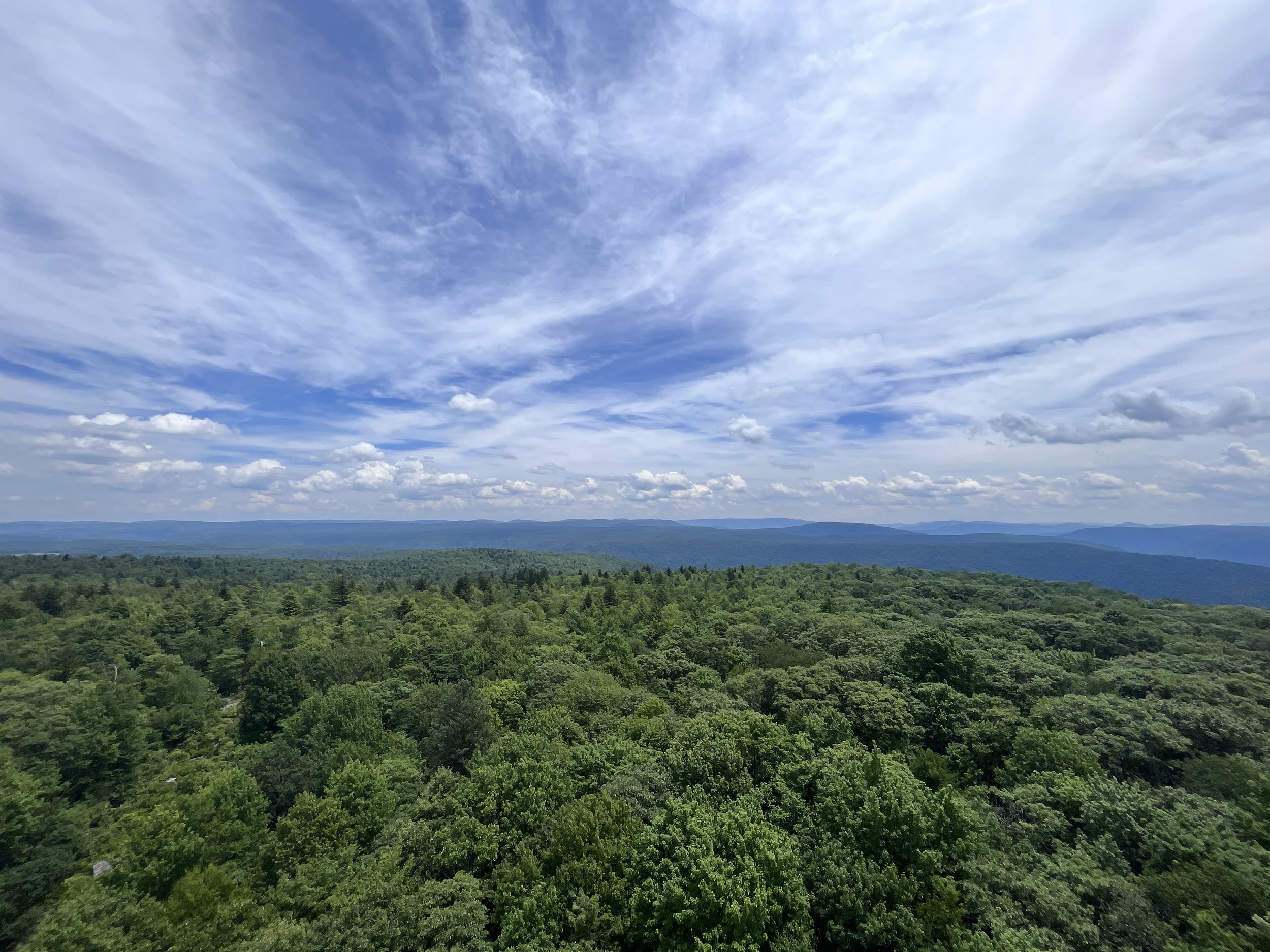CREATING HOME:
Indigenous Roots and Connections in the Appalachian Forest
In our 2024 seasonal exhibit, Creating Home: Indigenous Roots and Connections in the Appalachian Forest, we shared various stories of Indigenous cultural roots in our area, through art, language, and other stories. AFNHA learned from and collaborated with many Native artists and scholars, as well as non-Native scholars and archaeologists to put this together. There are many ways of showing the deep connections that Native people and communities have to this central Appalachian region, so this exhibit shared some introductory elements so that visitors can go learn more for themselves from Native Nations and culture keepers on their own.
See the full exhibit panels here. Note: files from this exhibit may not be used or reproduced without the express permission of AFNHA.
Many ways of knowing
There are many ways of knowing that we learn through our family stories, community traditions, historical writings, art, archaeology, and other forums.
Information presented here comes from diverse sources, both Indigenous and non-Indigenous, weaving together knowledge from many individuals, teams, and traditions.
This exhibit purposefully prioritizes knowledge and perspectives from Indigenous people, recognizing that each community will best tell their own stories.
This exhibit does include input from researchers who were outsiders to the communities they studied, with the understanding that pieces will have been lost in translation. The ways that Indigenous cultures and Western cultures conceive of “the past” are often different, and this exhibit sits amongst this intricacy and diversity.
Across cultures, the stories of time and the past are complex and this exhibit leaves them incomplete. Rather, we want to introduce a few ideas, and encourage you to learn more.
Below are the title panels of the main four sections of the exhibit, We Live Our Stories; (Re)Calling the Names; Our Relatives, The Forest; and We Are Still Here.


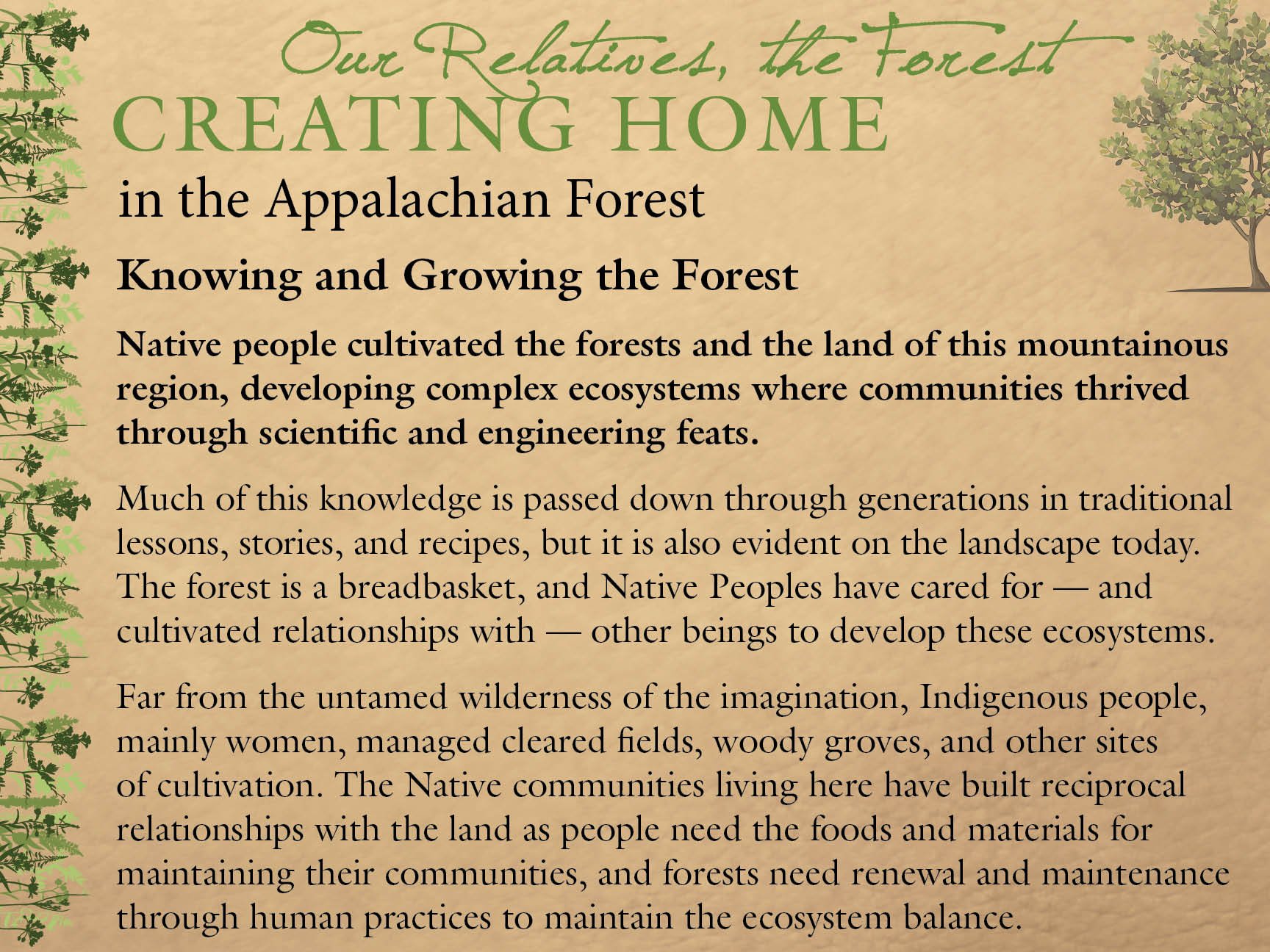
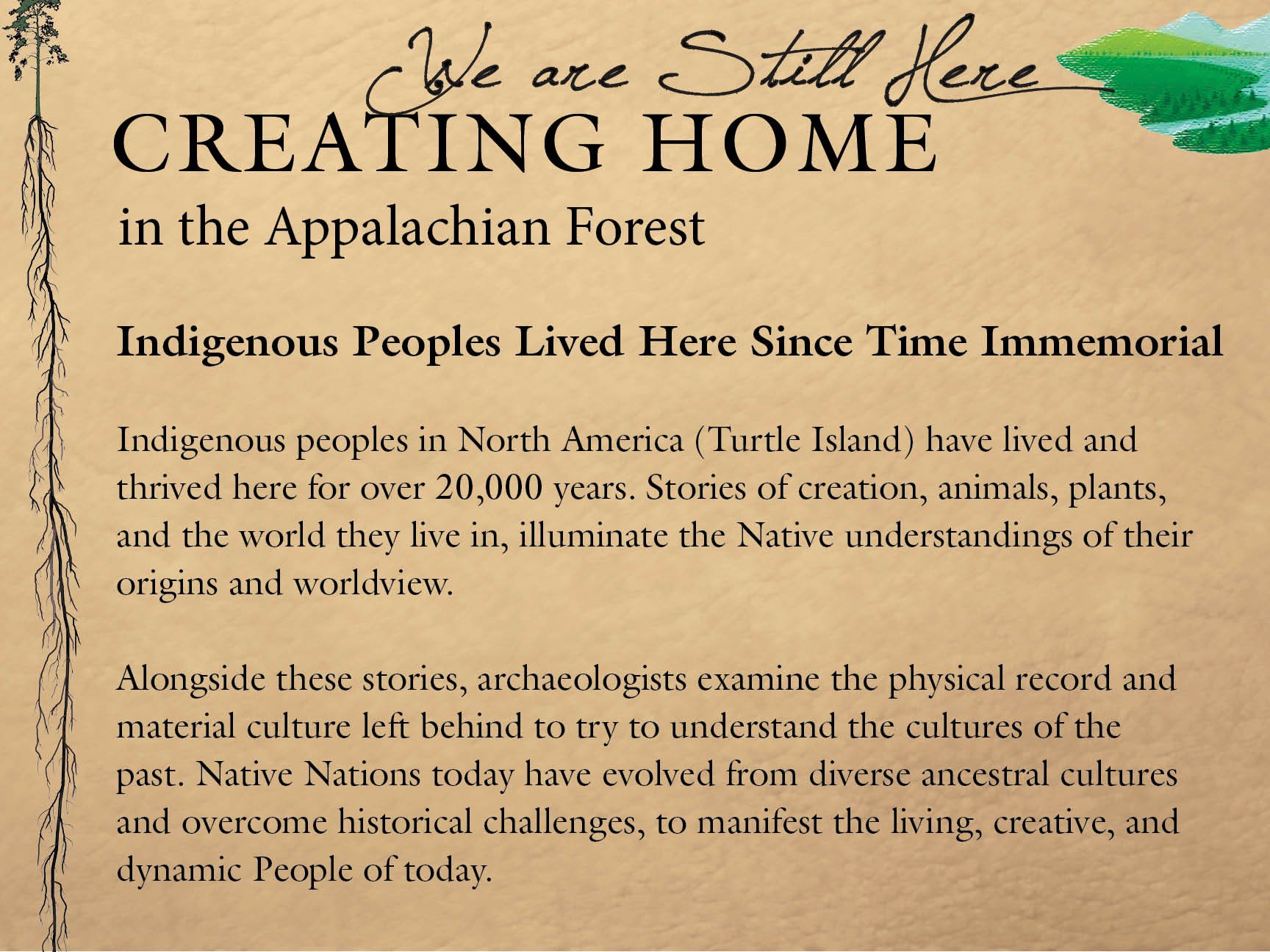
Through art and stories, Indigenous people use materials from the land to build their lives and traditions.
Through their art and their stories, makers share their culture and experience. Strong networks have connected the Indigenous communities of Central Appalachia to communities from elsewhere, so many non-local materials also become part of these traditions.
Storytelling and Memory-Making through Beadwork
Beadwork is an evolving art form that contributes to both culture-keeping and sharing with people from outside those communities.
Indigenous artists have long created work
with beads of shell, bone, stone, and more, working with materials from their locale and further afield. When trade between the Native Nations of Turtle Island and European nations began, Native artists started working glass beads into their pieces. Today, glass is often the primary material for beaders. Some older pieces can be approximately dated and attributed to certain Native cultures through details in the work. Raised beadwork on a 19th or early 20th century piece suggests Tuscarora or Mohawk origin, as primarily artists from those cultures crafted in that style at the time. Position of bird wings can also point to the culture of the piece’s maker.
The artform of quillwork also involves threading, weaving, and intricate stitchery.
Artists use the flattened and dyed quills of porcupines, an animal native to Turtle Island, stitching images and patterns to decorate clothing, build jewelry, and create dynamic works of art.
“I continue to share and teach traditional Seneca (no-face) cornhusk dolls and flowers to anyone willing to learn, especially the young and elders because
I feel it’s my responsibility to carry on what I’ve been taught especially from my Grandma Lillian. I am
thankful I can continue to carry on my family’s
tradition. Nya:weh.” —Bernadette Scott, Seneca, Deer Clan
Seneca horn husk doll created by Bernadette Scott. This doll was accessible on the exhibit touch table during the 2024 season.
Why No Faces? Read one story of corn husk dolls, as published by the Oneida Nation here.
Aren’t corn husk dolls an Appalachian tradition, too?
Folks who grew up in Appalachia might recognize these dolls, sometimes called corn shuck dolls. Making corn husk dolls is a common heritage practice, re-popularized during the crafts movement of the early 20th century. While not much is recorded about the specific origins of Appalachian corn husk dolls, clear lines can be drawn to the Native doll traditions. There was no maize in Europe or Africa prior to colonization—this tradition, like others, has passed from Native communities to non-Native communities over time.
The ancestral Shawnee pottery project aims to learn more about and revive the art of Shawnee ceramics.
Beginning with conversations between elders, the project is a collaborative effort between artists, academics, scientists, and others inside and outside of the three Shawnee Nations. The project team is working to recover knowledge that no one today knows, but Shawnee ancestors learned and put into practice frequently.
To recreate the steps of ancestor artists, participants have to perfect a new (or rather, very old) process from start to finish. Ancestor creators had mastered the engineering of the temper and clay mixture, the shaping of the pottery vessels, and the firing temperatures and timing for these ceramics. The team based their experiments around pieces of ceramics identified as likely made by Shawnee ancestors, often fragments found through archaeological methods. By comparing information from a variety of sources and disciplines, (“triangulating” previous research), the team has narrowed the region and time to a period that archaeologists call the “Fort Ancient” cultures. Many Shawnee people today see their roots, and the roots of other Indigenous Nations, in these Fort Ancient communities.
“When you study painting, you study the Dutch masters. Where are our masters? They are in the soil of our homelands.”
Chief Benjamin Barnes, Shawnee Tribe, “Fort Ancient/Shawnee Ceramics and the Revival of Shawnee Pottery,” 2022.
The original names of the land widely known as Appalachia were given by the Indigenous peoples who have lived in and around this region.
Over the many millennia that people have lived here, speaking Appalachian has meant different things. This Appalachian Forest has always been rich with language, and multicultural and multilingual communities form the backbone of this place.
Place Names, Original and Current
The First Peoples of this land named their towns, the waterways, forests, mountains, and other places throughout the sacred landscape, using terms from richly descriptive Indigenous languages. Reading these traditional place names is an important way to make connections across time and space.
Sources indicate “Appalachia” is derived from “Apalchen,” the name of a Muscogee village near what is now Tallahassee, Florida. In the 1500s the Spanish began to use the term as a generalization for the tribes and broader, mountainous landscape to the north.
As you travel throughout West Virginia, make note of the place names connected with Indigenous peoples, such as Seneca Rocks and Caverns, Allegheny Mountain Range, Ohio River, Kanawha River, Monongalia County, Shawnee Lake, Miami, Powhatan, and many more.
As you explore the exhibit and ponder the term “Indigenous Appalachia,” consider an excerpt from the poem “Homeland” by Monacan Nation poet Karenne Wood, Ph.D., 1960-2019, WVU Native American Studies 2010 Peace Tree Guest of Honor:
“Blue Mountains encircle a prayer
to the mist we call breath of the dead— everywhere, seeds lie dormant
in the ground.
This is a country remembered—
dogwoods, redbuds, deer at field’s edge,
the river roiled into its embrace of red earth.
We are powerless here, in the face of our love for legends of granite
and shapes that gather at night.
We are powerless
when mountain laurel spreads its stars through forests, when cedars dance with the yellow leaves falling,
and hawks cry out over us[...]
Nothing was discovered. Everything was already loved.”
Indigenous Names on the Landscape
As noted on the map, many names used widely today come from Indigenous languages, altered over time by variations in pronunciation and spelling.
The word Potomac likely comes from the town name spelled “Patawomeck” by John Smith in his map published in 1612. The people that lived in this town and other communities along the river may have called it different names, but this one has persisted due to the Patawomecks’ connections to Smith and his map.
Many of the names that non-Native folks have learned for Indigenous Nations are different from the names they use for themselves in English and their Indigenous languages. Whenever possible, this exhibit uses the words and names that Native Nations and communities use for themselves.
The English alphabet provides an additional challenge as it may not be
able to represent all sounds of each Indigenous language. The pronunciations of some words have been added in parentheses, written in the International Phonetic Alphabet (I.P.A.). The I.P.A. is a set of symbols developed by linguists to represent all the sounds that we know humans can make. Some I.P.A. symbols match English spelling, and some do not.
Native people cultivated the forests and the land of this mountainous region, developing complex ecosystems where communities thrived through scientific and engineering feats.
Much of this knowledge is passed down through generations in traditional lessons, stories, and recipes, but it is also evident on the landscape today. The forest is a breadbasket, and Native Peoples have cared for — and cultivated relationships with — other beings to develop these ecosystems.
Far from the untamed wilderness of the imagination, Indigenous people, mainly women, managed cleared fields, woody groves, and other sites of cultivation. The Native communities living here have built reciprocal relationships with the land as people need the foods and materials for maintaining their communities, and forests need renewal and maintenance through human practices to maintain the ecosystem balance.
Yunwi Anidonav, Standing People
The Cherokee, Haudenosaunee, and other Eastern Nations know the trees as “Standing People,” or, “Tall People.”
When harvesting one of the Yunwi Anidonav, Cherokee traditionally say a prayer of thanksgiving and make an offering of beads or tobacco to show respect. Trees are considered relatives who gave life through food, shelter, and warmth. Their arms become beautiful furnishings, utensils, and crafts. Their bodies provide fire for cooking meals, and that gift makes every meal sacred.
While the lives of all Yunwi Anidonav are considered sacred, the atsina, or cedar, has been the most revered. Because she kept vigil with the Creator, she is allowed to keep her hair all year long. Her aroma keeps evil spirits away. Cedar is never used for a cooking or hearth fire, but as incense, medicine, musical instruments, or furniture.
Shared by Larry Jent, Cherokee
Shaping the Forest
Indigenous people practiced silviculture, the development and management of forests and woodlands, looking at all parts of these ecosystems to meet the needs of humans and the environment.
Planned burning is a widely used practice in United States forestry today, but it is not new. Native people consistently burned and thinned the Appalachian forests as early as 6000 years ago, engineering an ecosystem where fire-loving species, like oaks and hickory thrive.
The Indigenous people of this continent also practiced tree girdling: stripping a section of bark all the way around the trunk of a tree or other woody plant, leaving it unable to send nutrients above the cut. This kills a tree, but leaves it standing, offering the lower stories of the forest beneath the tree’s canopy a longer adjustment period as the area enters a new stage of growth.
Varied stages of forest regrowth generate diverse ecosystems, so by regularly burning and girdling different tracts of forest, Indigenous communities created the types of habitat they wanted for game, food, and forest materials. Their forestry practices increased the range and number of nut trees and fruit plants, and developed the wide menu of known Appalachian edible plants today.
Indigenous people established the presence of acorns, chestnuts, strawberries, blueberries, ramps, and so many others. Communities did not use the same fields for too long, clearing new ones to let soil replenish, just as fields are rotated today.
Indigenous communities of the past also engineered the environment to expand animal range.
Mammals, birds, and fish were all sustainably and respectfully harvested for food and other uses. Among these were the American bison. While usually thought of as a central plains animal, bison range extended into the Appalachian mountains and beyond. Herds utilized grasslands created by Native communities. Bison and other large animals often shared preferred routes through the mountains with Native roads.
Bison are known as ᏯᎾᏏ (ya-na-si) in ᏣᎳᎩ (tsa-la-gi, Cherokee in English). Like other eastern Nations, Cherokee people, maintained bison populations east of the Mississippi River before European colonization. Today, the Cherokee Nation in Oklahoma maintains a herd of bison, currently around 150 animals.
Bison, a mixed media work of art by April Branham (Monacan).
The emerald ash borer impacts tradition.
Black ash is commonly used among Northeastern Indigenous people, due to the wood’s flexibility and strength. Many Indigenous artists, including Penny Minner, continue to make baskets and other objects from traditional materials like ash. Unfortunately, these traditions are at risk due to the invasive emerald ash borer putting a strain on the black ash population.
Building the World’s Plate
The Indigenous peoples of the Western Hemisphere developed about sixty percent of the foods that make up the global human diet.
These plants did not reach their current forms on their own. Indigenous people selectively bred their predecessors into useful and delicious food sources. Indigenous gardeners, farmers, cooks, and chefs today continue to innovate the world’s cuisine. In the Appalachian Forest, we have Native communities to thank for cornbread, soup beans, and so much more.
For example: the nightshade family includes an endless array of plants—edible, ornamental, and medicinal. Without the millennia of selective cultivation by Native communities, these would not exist in their present forms. They form the culinary traditions of many cultures worldwide.
Indigenous Peoples Have Lived Here Since Time Immemorial
Indigenous peoples in North America (Turtle Island) have lived and thrived here for over 20,000 years. Stories of creation, animals, plants, and the world they live in, illuminate the Native understandings of their origins and worldview.
Alongside these stories, archaeologists examine the physical record and material culture left behind to try to understand the cultures of the past. Native Nations today have evolved from diverse ancestral cultures and overcome historical challenges, to manifest the living, creative, and dynamic People of today.
As the climate warmed following the Ice Age, the forests in this area emerged from tundra.
The retreat of glaciers led to growth of coniferous forests, then mixed with northern hardwoods outside the highest elevations. The mammoth and mastodon were replaced by modern species such as deer and elk.
Early peoples traveled long distances to find resources, see family members and friends, visit sacred sites, and trade for valued items, returning to to their homes in the mountains and valleys.
They quarried chert to make projectile points and tools, hunted game, and gathered nuts, berries, and seasonally available plants.
As the climate moderated, Native populations grew with increasing settlements both along rivers and in upland areas. They grew plants like sunflowers, squash, and gourds, and preserved food for the future.
The fluted points and other tools of early Native people have been found in the mountains of this region, as well as across the Northeast and the whole of Turtle Island. Early projectile points and evidence of rockshelter use dating from around 12,000 years ago have been found along many river valleys in Maryland and West Virginia, such as the North Branch and South Branch of the Potomac, Cheat, and Tygart Valley Rivers.
making home in the highlands
Indigenous people sometimes sheltered under rock overhangs to create shelter while traveling and hunting, or for more extended living. Rockshelter use across our region has been documented with early Folsom points through to historic era. In order to protect them, most known rockshelter sites are not open to the public.
Woodlands as Home to Native Peoples
The Americas flourished with life during the period from approximately 3,000 years ago through 1200 CE.
For Turtle Island (North America) archeologists label this as the Woodland Period. These ancestors were culturally diverse with distinctive languages and regional practices.
Indigenous peoples continued to hunt and gather food, but also developed agriculture, created pottery, constructed mounds, played music and sports, and built complex cities, such as Cahokia in the Mississippi Valley, which was home to roughly 20,000 people at its peak.
In the central Appalachians, populations were more sparse due to mountainous terrain, but villages were especially common along rivers. People cultivated corn, beans, squash, tobacco, and sunflowers, constructed storage facilities, and harvested from the forests and mountain uplands that surrounded their communities.In many cases, towns would be moved after a few decades, to seek out new locations with fertile soil.
In the latter centuries before European contact, many towns had grown larger, often with protective stockades. Communities cultivated a substantial portion of their food, hunted with the bow and arrow, and developed long term
Early Woodland Tools, including bow, projectile points, and lithic drill points —National Park Service food preservation and storage methods. Different cultures had distinct house structures, pottery, and cultural practices. Multiple sites are known within the Appalachian Forest area, including mounds and village sites along the North Branch and South Branch of the Potomac, and along the Cheat, Tygart Valley, Little Kanawha, and Greenbrier Rivers.
Burial and ceremonial mounds and elaborate earthworks were built by Indigenous engineers throughout much of Turtle Island. Within the Appalachian Forest area, a number of relatively small burial mounds, classified by archaeologists as Adena mounds, were recorded by early European explorers. Most of these were destroyed by colonial settlers.
The Hyre mound along the Seneca Trail in Randolph County remained until 1963, when it was excavated by archaeologist Bettye Broyles. She concluded that there had been repeated short term occupations of the site ranging about 400 BCE to 1400 CE.
Seneca Rocks Settlements
At Seneca Rocks, the dramatic and sacred rock outcropping overlooking the headwaters of the South Branch of the Potomac offered a fertile location for towns and villages.
Archaeologists have found signs of substantial settlements here, dating to around 1160 and 1360 CE, along with evidence of prior use of the location from 600 CE and earlier.
The people who lived here built their houses in a circle around an open plaza which they used for communal gatherings and work, for social and ceremonial activities, and as a playing ground for children. Archaeologists estimate that up to 150 people made up the town, living with their extended families in 12 large houses. Each house was about 32 feet long and 20 feet wide. They were built of saplings lashed to form domes and covered by bark, skins, or thatch.
The hearth was the center of the home, providing heat for comfort and cooking, and was surrounded by family members’ sleeping benches.
Yunwi Tsunsdi’
Nearly every culture on earth has stories about magical little people.
In the Seneca language, The Rocks are known as Jögä:ö’, meaning “Little people live there.” The Cherokee call them the Yunwi Tsunsdi’.
They are magical creatures. Most of the time they are invisible, but they can appear at will. They are kind and helpful by nature, but often mischievous. They love to hide things and play pranks.
When angry they can be dangerous, so travelers would leave offerings to show them respect.
Sometimes it was food, but a pebble would do--just something to acknowledge their presence. Hikers in the deep woods may come across a pile of small stones near rock outcrops, small caves, or cracks in a rock wall. These were offerings to the Yunwi Tsunsdi’, accumulated over hundreds of generations. Laugh if you like, but if you see a mound of pebbles it would be wise to leave a stone of your own. You don’t want to upset the Yunwi Tsunsdi’!
Pathways to Today
The journeys of Native Peoples from ancestral homelands to sovereign Nations today has been challenging.
Indigenous people of many ancestor cultures across Turtle Island traded, intermarried, fought, and shared territories with each other. These communities did not exist within a vacuum but responded to the world around them.
The coming of Europeans triggered chaos and change. Diseases, non-stop European migration, international trade, destructive wars, and ever-developing political policies took the land that had been Native homeland for millennia and disrupted long-standing Indigenous lifeways.
Native Nations have survived nearly four centuries of war and genocidal policies, enforced removal, residential school assimilation, and religious conversion. These Nations today continue to affirm their self-determination and revitalize their cultural knowledges.
As sovereign Nations, most provide social, governmental, and educational services for their citizens, and safeguard their culture, language, and traditions. While there are no federally- recognized Native Nations residing in West Virginia or Maryland, many individuals or nuclear families chose to live here.
The Nations described here are among those who cherish connections to the Appalachian highlands.
